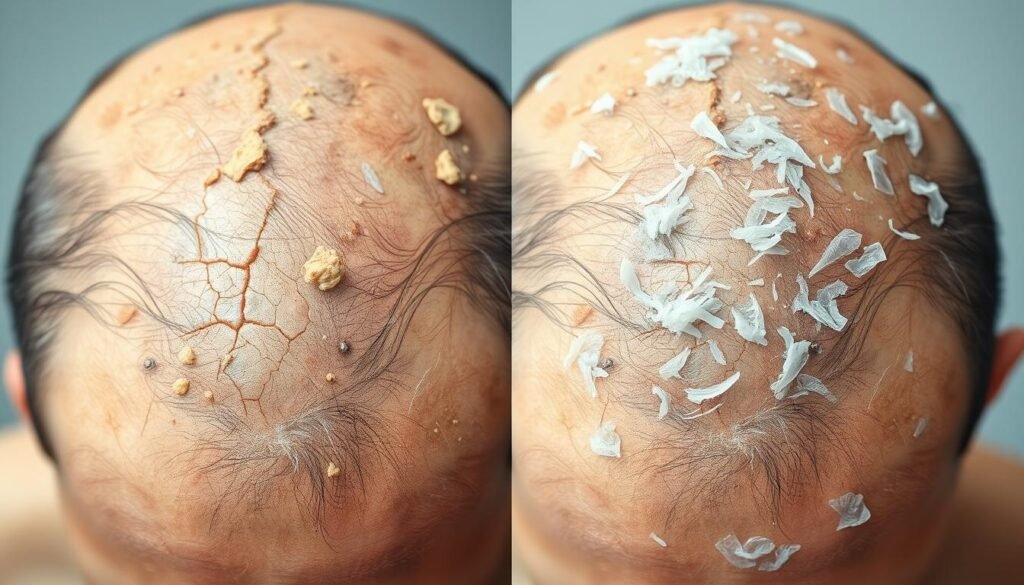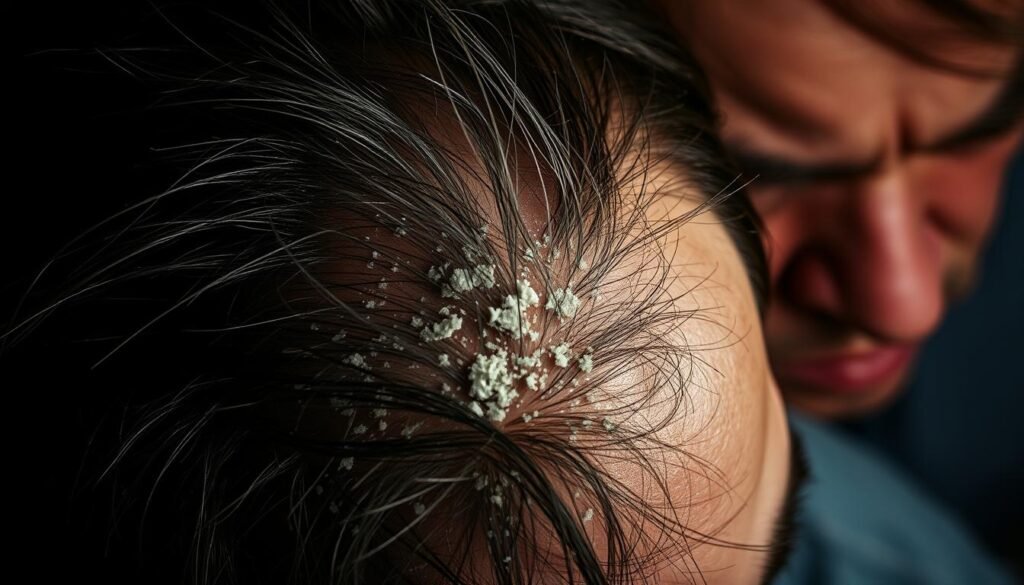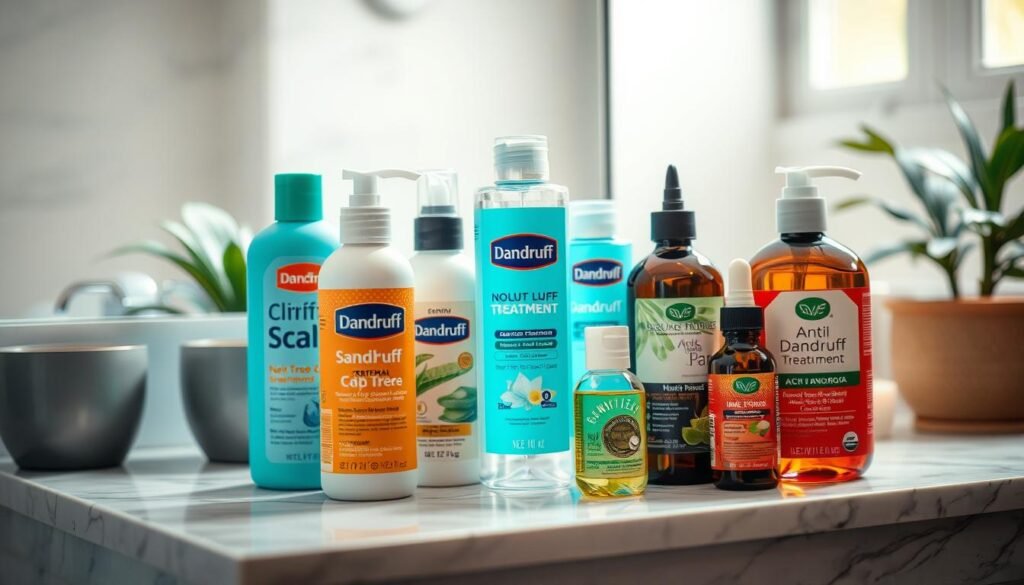Did you know that nearly half of all adults around the world have dandruff? This issue usually starts in young adulthood and may continue till middle age. It is more common in men than women. Though dandruff isn’t dangerous, it can cause embarrassment due to scratching and visible flakes. It’s important to understand why dandruff happens to keep our scalp healthy.
Various factors cause dandruff, such as dry skin, too much oil, and fungal infections like Malassezia. Those with Parkinson’s disease or weaker immune systems may face more risk. During winter, dandruff can get worse. Knowing the reasons behind dandruff and finding effective treatments are key steps.
Key Takeaways
- Dandruff affects nearly 50% of the global adult population.
- Males are more prone to dandruff compared to females.
- Conditions like Parkinson’s disease and immune suppression increase dandruff risks.
- Winter weather often worsens symptoms due to drier skin.
- Malassezia, a fungus, plays a significant role in dandruff development.
- Maintaining a consistent and healthy scalp health routine is vital for managing dandruff.
- Over-the-counter shampoos and home remedies can be effective treatment options.
Understanding Dandruff and Scalp Health
Dandruff is more than just flakes on your shoulders. It can really affect your scalp’s health. It starts with the skin cells on your scalp shedding too much. This creates visible flakes that can be pretty annoying. Knowing about dandruff is key to dealing with it. It often comes from problems like dry skin or a condition called seborrheic dermatitis. Both can make your scalp more flaky and itchy.
About 20% of people deal with dandruff. That’s one in five folks. Men are more likely to get it because they tend to have oilier skin. A yeast called malassezia on the scalp can also cause trouble. Washing your hair two to three times a week can be a big help. It keeps your scalp clean and healthy.
Things like harsh hair products, getting older, and dry weather can lead to a dry scalp. Keeping your hair care routine simple and using moisturizing shampoos can help. This balance is key in avoiding dandruff.
How dandruff affects you can depend on different things happening on your scalp. Keeping your scalp clean and using the right care products is very important. They help soothe your scalp and keep it in good shape.
Common Symptoms of Dandruff
Dandruff shows up in a few clear ways. Knowing these signs helps people find the right treatment. One main symptom is oily flakes in the hair or on clothes, which feels awkward and embarrassing. Another issue is an itchy scalp. This itchiness can push someone to scratch, causing even more irritation.
Identifying Oily Flakes
Oily flakes are a big clue you might have dandruff. They land on your shoulders and can be white or yellow. It’s crucial to spot these flakes early. That way, you can tackle dandruff by choosing the best hair care.
Recognizing Itchy Scalp
An itchy scalp is common for those dealing with dandruff. This annoying itch comes from irritation. Knowing why your scalp itches, like dryness or too much oil, helps you find the right solution.
Other Related Symptoms
There are other signs to watch out for too. Symptoms like scalp redness and irritation show up often. This redness means your scalp is inflamed, sometimes made worse by scratching or bad hair products. You might also see dry patches, which confuse the picture. Keeping an eye on these signs helps in figuring out how bad the dandruff is and what to do about it.
| Symptom | Description |
|---|---|
| Oily Flakes | White or yellowish flakes that appear in hair or on clothing, resulting from excess oil on the scalp. |
| Itchy Scalp | Discomfort caused by irritation, often triggering scratching that worsens the condition. |
| Scalp Redness | Inflammation and irritation of the scalp, which may accompany scratching or ineffective products. |
| Dry Patches | Areas of dryness that may resemble other skin conditions, complicating dandruff treatment. |
Why Do I Have Dandruff? Exploring the Causes
Dandruff has many causes, each playing a part in its development. Dry skin is a big cause, especially in winter. The cold dries out the scalp, causing more dandruff. Not shampooing enough can also lead to oil buildup, which feeds fungal infection.
Seborrheic dermatitis is another common cause. It affects areas with many oil glands. This results in visible dandruff and a red scalp. This condition can get worse with seasonal changes or stress.
Malassezia, a scalp fungus, can also make dandruff worse. This is especially true for those who are sensitive to it. Some might react to hair products, leading to itchiness and soreness.
Hormonal changes, like those during puberty, often bring on dandruff. Men are more affected due to male hormones. Some health issues, such as Parkinson’s disease, can also increase dandruff risk.
Keeping your scalp clean is key in controlling dandruff. Washing regularly with the right shampoos can make a big difference. Brands like Head & Shoulders are known to help manage this problem well.
| Cause | Details |
|---|---|
| Dry Skin | More common in winter; leads to increase in dandruff. |
| Seborrheic Dermatitis | Chronic condition characterized by dandruff and redness. |
| Fungal Infection (Malassezia) | Triggers dandruff and worsens in sensitive individuals. |
| Allergic Reactions | Allergies to hair care products can cause scalp irritation. |
| Hormonal Changes | Common during puberty and may persist into middle age. |
| Other Health Conditions | Increased risk in individuals with Parkinson’s disease. |
Understanding the causes helps in better managing and treating dandruff. This leads to a healthier scalp.
Dry Scalp vs. Dandruff: What’s the Difference?
It’s important to know the difference between dry scalp and dandruff for the right treatment. Although both can cause flakes and itching, their causes and treatments are much different.
Understanding Dry Scalp
Dry scalp happens when there’s not enough moisture. It can result from cold air, harsh products, or not drinking enough water. You may see small white flakes which can itch or feel uncomfortable. Using moisturizers more often or washing your hair less can help fix dryness.
How to Differentiate Between the Two
Knowing the difference between dandruff and dry scalp is crucial. Dandruff flakes are usually larger and oilier, appearing yellow or white. It’s often due to too much Malassezia, a yeast on our scalps. Here’s how they compare:
| Condition | Appearance of Flakes | Common Symptoms | Treatment |
|---|---|---|---|
| Dry Scalp | Smaller, dry white flakes | Itchy, tight feeling | Gentle shampoo, moisturizing conditioner |
| Dandruff | Larger, oily, yellow or white flakes | Itchy, red, scaly skin | Medicated shampoos with antifungal ingredients |
For best results, choose your treatment based on your specific condition. Knowing the symptoms and understanding these conditions will help you take better care of your scalp.

The Role of Malassezia in Dandruff
Malassezia plays a key role in dandruff. This dandruff fungus lives naturally on our scalps. It grows best in oil-rich areas. Knowing how it affects our scalp is vital, especially when it grows too much.
What is Malassezia?
Malassezia is a group of fungi. Malassezia globosa is one type that’s closely linked to dandruff. About half of us may react badly to it. This reaction can cause itching and flaking. When Malassezia breaks down sebum, it makes oleic acid. For some, this acid causes worse dandruff. It shows why controlling Malassezia growth is important for a healthy scalp.
How it Affects Scalp Health
Malassezia’s effect on scalp health is clear. People with dandruff often have much more Malassezia. This leads to faster skin renewal and thus, flaking. Using Head & Shoulders Anti-Dandruff Shampoos helps. These shampoos slow down Malassezia’s growth, helping your scalp stay healthy.
Also, a good hair care routine matters. Stop scratching, use fewer hair products, and wash your hair often. Even some sunlight is good, but don’t forget sunscreen. These steps can lower dandruff outbreaks.
| Key Insights | Details |
|---|---|
| Population Sensitivity | 50% react negatively to Malassezia globosa |
| Allergic Reaction | 50% allergic to oleic acid by-product |
| Fungal Density | 10x more Malassezia on dandruff scalps |
| Bacterial Presence | Staphylococcus capitis found 100x more on dandruff-affected scalps |
| Effectiveness of Treatments | Head & Shoulders proven to control Malassezia |
Impact of Stress on Dandruff Development
Stress can worsen dandruff but is not its main cause. When people are chronically stressed, their immune system can weaken. This makes the scalp more prone to dandruff triggers like bacteria or yeast.
Hormonal changes caused by stress can also increase oil on the scalp. It’s important to notice how stress affects dandruff symptoms. Look at the dandruff severity, flake size, and if you’re touching your hair more often.
To fight stress-related dandruff, try exercising regularly and avoiding stress when possible. Using special shampoos such as Oribe Serene Scalp Anti-dandruff Shampoo, DHS Tar Shampoo, and Jupiter Balancing Shampoo can help manage it temporarily. Studies show stress can make inflammation worse and lead to more sebum, making dandruff worse.
Dandruff is often more common in warm months due to more sweat and oil. In winter, people with dry scalp may have more problems because the air is drier.
Certain shampoos with zinc pyrithione and ketoconazole can fight yeast. Salicylic acid shampoos help reduce oil and fight yeast. Tea tree oil shampoos are good too because they fight germs and reduce swelling. For serious or inherited dandruff, see a skin doctor.

Hair Care Routine and Dandruff
Maintaining a good hair care routine is key to managing dandruff. It also helps promote a healthy scalp. Knowing what causes dandruff can really help improve things for anyone dealing with it.
Shampooing Frequency Matters
It’s important to find the right balance in how often you wash your hair. Not washing enough can lead to oil and skin cells building up. This can make dandruff worse. However, washing too much can remove the scalp’s natural oils, leading to dryness.
For most people, washing their hair two to three times a week works well. Adjusting how often you wash your hair, considering how oily it gets and your lifestyle, can help keep your scalp healthy.
Choosing the Right Hair Products
Choosing the right products is crucial when dealing with dandruff. Dandruff shampoos have different key ingredients, such as:
| Shampoo Type | Active Ingredient | Purpose |
|---|---|---|
| Common Dandruff Shampoo | Pyrithione zinc | Reduces yeast on the scalp |
| Tar-based Shampoo | Coal tar | Slows down skin cell production |
| Salicylic Acid Shampoo | Salicylic acid | Helps to exfoliate and remove flakes |
| Selenium Sulfide Shampoo | Selenium sulfide | Reduces itching and flaking |
| Antifungal Shampoo | Ketoconazole | Targets fungal growth |
Using these shampoos correctly is often key to their effectiveness. Experts suggest leaving the shampoo on for at least five minutes for the best results. Switching between a few shampoos can reduce irritation and make your routine more effective.
Also, it’s smart to limit the use of styling products, as they can cause buildup. Adapting your hair and scalp care to your personal needs can really help keep your scalp healthy and manage dandruff.
Dandruff Treatments: What’s Available?
There are many ways to treat dandruff, from over-the-counter shampoos to prescription solutions. Each product works differently, offering relief based on what you need. It’s important to manage dandruff regularly to keep your scalp healthy.
Over-the-Counter Dandruff Shampoos
Over-the-counter shampoos can be very effective for dandruff. They often have ingredients like coal tar, pyrithione zinc, and salicylic acid. These help fight dandruff symptoms and make your scalp healthier.
Using an over-the-counter shampoo regularly can improve mild dandruff in a few weeks. There is plenty of advice available on how to use these shampoos properly. This includes recommendations on medicated products.
Prescription Options for Severe Cases
If dandruff is severe or doesn’t get better with over-the-counter treatments, you might need a prescription. Dermatologists offer strong treatments customized for you. You might get fluocinolone or calcineurin inhibitors if your dandruff sticks around.
Natural treatments can also help, adding to the power of prescription solutions. You may have to use medicated shampoos along with your regular shampoo for the best results.

| Treatment Type | Active Ingredients | Usage Frequency |
|---|---|---|
| Over-the-Counter Shampoos | Coal Tar, Pyrithione Zinc, Salicylic Acid | Up to 3 times a week |
| Prescription Solutions | Fluocinolone, Calcineurin Inhibitors | As directed by a doctor |
Trying different dandruff treatments can greatly improve your scalp health. Keeping a good care routine and watching your diet also helps with dandruff. For tips on a healthy scalp care routine, check out this guide.
Home Remedies for Managing Dandruff
Many people with dandruff look for home treatments. They often use ingredients found at home. These DIY methods can help traditional treatments and keep the scalp healthy.
Natural Ingredients to Try
Some effective home remedies for dandruff include:
- Coconut Oil: Known for moisturizing, coconut oil can hydrate the scalp and lessen irritation.
- Apple Cider Vinegar: It balances scalp pH and may reduce dandruff.
- Aloe Vera: Aloe vera has antifungal properties, soothing the scalp and preventing fungus.
- Tea Tree Oil: This oil has antibacterial qualities good for scalp health.
- Lemongrass Oil: Research shows lemongrass oil might decrease dandruff, making it a good natural option.
Benefits of Scalp Massages
Gentle scalp massages can improve home dandruff treatments. Massaging the scalp boosts blood flow, helping overall scalp health and possibly reducing dandruff. Scalp massages are relaxing and spread natural oils through the hair.
Conclusion
Understanding how to manage dandruff is crucial for anyone with this scalp issue. Dandruff shows as white or yellow flakes and can make your scalp itchy. Knowing why it happens helps people find the right solutions for a healthy scalp. This often involves issues like Malassezia growth or reactions to certain hair products.
There are many treatments available that work well. Using the right shampoos and treatments tackle the problem’s root. Keeping your hair and scalp clean is also key to reducing symptoms. Natural solutions like tea tree oil or apple cider vinegar can also help. Making changes in how you live, like reducing stress, can improve both your scalp health and your happiness.
Being informed about dandruff boosts confidence in handling it. You can choose over-the-counter products or try remedies at home. Taking action early keeps dandruff under control. For more details on keeping a healthy scalp and fighting dandruff, check out resources at dandruff awareness initiatives.